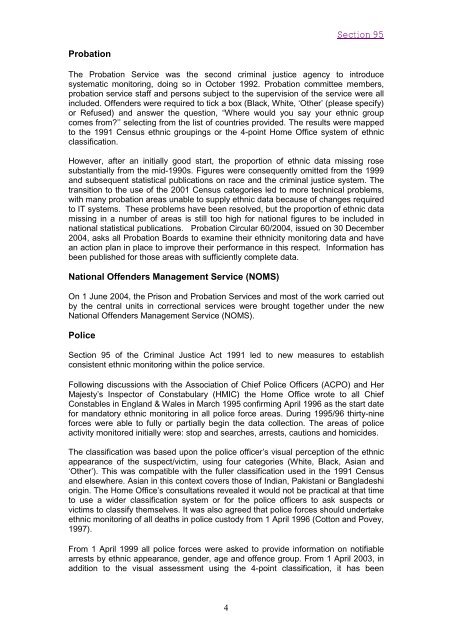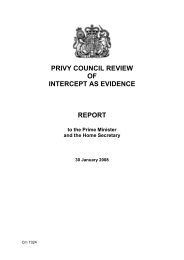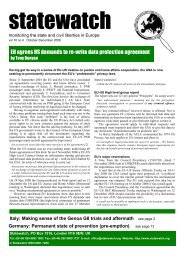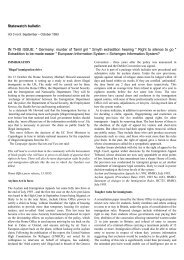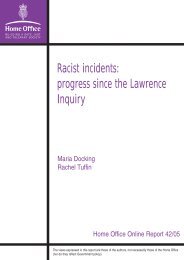Statistics on Race and the Criminal Justice System - 2005 - Statewatch
Statistics on Race and the Criminal Justice System - 2005 - Statewatch
Statistics on Race and the Criminal Justice System - 2005 - Statewatch
You also want an ePaper? Increase the reach of your titles
YUMPU automatically turns print PDFs into web optimized ePapers that Google loves.
Secti<strong>on</strong> 95<br />
Probati<strong>on</strong><br />
The Probati<strong>on</strong> Service was <strong>the</strong> sec<strong>on</strong>d criminal justice agency to introduce<br />
systematic m<strong>on</strong>itoring, doing so in October 1992. Probati<strong>on</strong> committee members,<br />
probati<strong>on</strong> service staff <strong>and</strong> pers<strong>on</strong>s subject to <strong>the</strong> supervisi<strong>on</strong> of <strong>the</strong> service were all<br />
included. Offenders were required to tick a box (Black, White, ‘O<strong>the</strong>r’ (please specify)<br />
or Refused) <strong>and</strong> answer <strong>the</strong> questi<strong>on</strong>, “Where would you say your ethnic group<br />
comes from?’’ selecting from <strong>the</strong> list of countries provided. The results were mapped<br />
to <strong>the</strong> 1991 Census ethnic groupings or <strong>the</strong> 4-point Home Office system of ethnic<br />
classificati<strong>on</strong>.<br />
However, after an initially good start, <strong>the</strong> proporti<strong>on</strong> of ethnic data missing rose<br />
substantially from <strong>the</strong> mid-1990s. Figures were c<strong>on</strong>sequently omitted from <strong>the</strong> 1999<br />
<strong>and</strong> subsequent statistical publicati<strong>on</strong>s <strong>on</strong> race <strong>and</strong> <strong>the</strong> criminal justice system. The<br />
transiti<strong>on</strong> to <strong>the</strong> use of <strong>the</strong> 2001 Census categories led to more technical problems,<br />
with many probati<strong>on</strong> areas unable to supply ethnic data because of changes required<br />
to IT systems. These problems have been resolved, but <strong>the</strong> proporti<strong>on</strong> of ethnic data<br />
missing in a number of areas is still too high for nati<strong>on</strong>al figures to be included in<br />
nati<strong>on</strong>al statistical publicati<strong>on</strong>s. Probati<strong>on</strong> Circular 60/2004, issued <strong>on</strong> 30 December<br />
2004, asks all Probati<strong>on</strong> Boards to examine <strong>the</strong>ir ethnicity m<strong>on</strong>itoring data <strong>and</strong> have<br />
an acti<strong>on</strong> plan in place to improve <strong>the</strong>ir performance in this respect. Informati<strong>on</strong> has<br />
been published for those areas with sufficiently complete data.<br />
Nati<strong>on</strong>al Offenders Management Service (NOMS)<br />
On 1 June 2004, <strong>the</strong> Pris<strong>on</strong> <strong>and</strong> Probati<strong>on</strong> Services <strong>and</strong> most of <strong>the</strong> work carried out<br />
by <strong>the</strong> central units in correcti<strong>on</strong>al services were brought toge<strong>the</strong>r under <strong>the</strong> new<br />
Nati<strong>on</strong>al Offenders Management Service (NOMS).<br />
Police<br />
Secti<strong>on</strong> 95 of <strong>the</strong> <strong>Criminal</strong> <strong>Justice</strong> Act 1991 led to new measures to establish<br />
c<strong>on</strong>sistent ethnic m<strong>on</strong>itoring within <strong>the</strong> police service.<br />
Following discussi<strong>on</strong>s with <strong>the</strong> Associati<strong>on</strong> of Chief Police Officers (ACPO) <strong>and</strong> Her<br />
Majesty’s Inspector of C<strong>on</strong>stabulary (HMIC) <strong>the</strong> Home Office wrote to all Chief<br />
C<strong>on</strong>stables in Engl<strong>and</strong> & Wales in March 1995 c<strong>on</strong>firming April 1996 as <strong>the</strong> start date<br />
for m<strong>and</strong>atory ethnic m<strong>on</strong>itoring in all police force areas. During 1995/96 thirty-nine<br />
forces were able to fully or partially begin <strong>the</strong> data collecti<strong>on</strong>. The areas of police<br />
activity m<strong>on</strong>itored initially were: stop <strong>and</strong> searches, arrests, cauti<strong>on</strong>s <strong>and</strong> homicides.<br />
The classificati<strong>on</strong> was based up<strong>on</strong> <strong>the</strong> police officer’s visual percepti<strong>on</strong> of <strong>the</strong> ethnic<br />
appearance of <strong>the</strong> suspect/victim, using four categories (White, Black, Asian <strong>and</strong><br />
‘O<strong>the</strong>r’). This was compatible with <strong>the</strong> fuller classificati<strong>on</strong> used in <strong>the</strong> 1991 Census<br />
<strong>and</strong> elsewhere. Asian in this c<strong>on</strong>text covers those of Indian, Pakistani or Bangladeshi<br />
origin. The Home Office’s c<strong>on</strong>sultati<strong>on</strong>s revealed it would not be practical at that time<br />
to use a wider classificati<strong>on</strong> system or for <strong>the</strong> police officers to ask suspects or<br />
victims to classify <strong>the</strong>mselves. It was also agreed that police forces should undertake<br />
ethnic m<strong>on</strong>itoring of all deaths in police custody from 1 April 1996 (Cott<strong>on</strong> <strong>and</strong> Povey,<br />
1997).<br />
From 1 April 1999 all police forces were asked to provide informati<strong>on</strong> <strong>on</strong> notifiable<br />
arrests by ethnic appearance, gender, age <strong>and</strong> offence group. From 1 April 2003, in<br />
additi<strong>on</strong> to <strong>the</strong> visual assessment using <strong>the</strong> 4-point classificati<strong>on</strong>, it has been<br />
4


